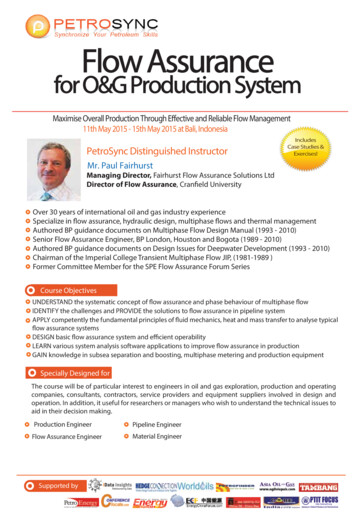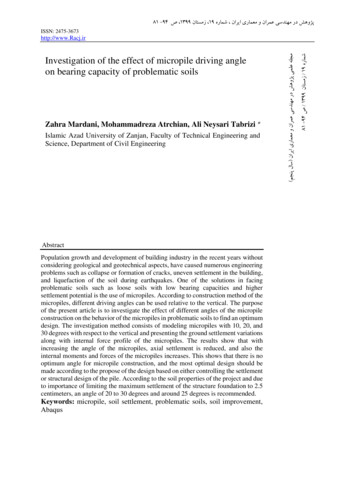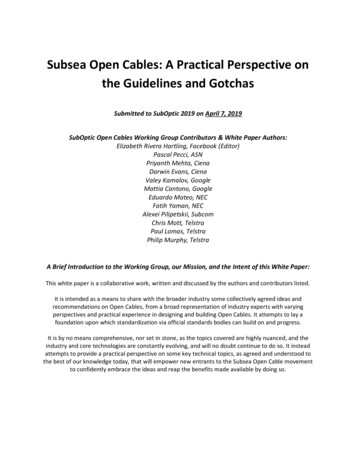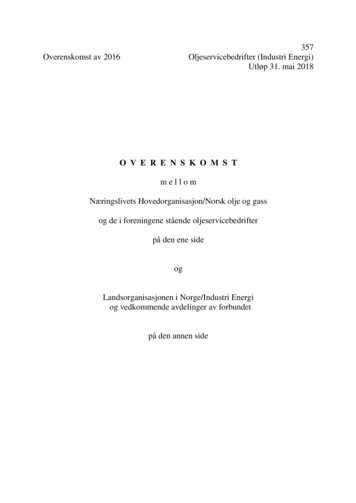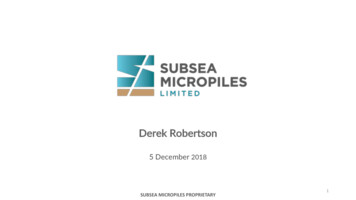
Transcription
Derek Robertson5 December 2018SUBSEA MICROPILES PROPRIETARY1
History First use dates back to the early 1950’s in Italy, where new methods ofunderpinning for existing structures were needed to restore structures andmonuments damaged during World War II. Dr. Fernando Lizzi is commonly recognized as the inventor of micropiles in theform of the tree root pile or "palo-radice". Rapid growth in the specification and use of micropiles in the United Statessince the mid 1980’s to early 1990’s partly as a result of Federal HighwayAdministration research efforts. Micropiles currently are now widely specified and used in all terrestialconstruction sectors worldwide.SUBSEA MICROPILES PROPRIETARY2
Micropiles
Lockheed Martin IP Under its Ocean Thermal Energy Conversion program,Lockheed Martin developed IP for the adaptation ofterrestrial micropiles to the marine environment, usingremote seabed drilling and grouting systems. Since 2008, research and development has been carriedout to advance designs and key operational concepts toinclude testing of optimal grout formulations andinjection systems. U.S. Patent No. 9,051,030q “Undersea Anchoring System and Method”q Co-inventors John E. Halkyard and Jonathan B. Machin Subsea Micropiles Limited secures exclusive worldwidelicense to Lockheed Martin IP (Jan 2018)SUBSEA MICROPILES PROPRIETARY4
Why offshore now? Advent of robotic underwater drilling systems Need to substantially reduce cost basis ofoffshore foundations and structuresRecent developmentof remote seabeddrills is an enablingtechnology More challenging subsea environment Advanced marine structures need compliantanchor/stabilization solutions Increased demand to minimize environmentalimpacts Improve safety with increasedautomation/ROV’sRock dumping - Micropilesolutions are costeffective alternative forpipeline stabilizationSUBSEA MICROPILES PROPRIETARYOperators are keento remove humanintervention fromsubsea operations5
Value propositionExample of a pipeline hold-back anchor w/required capacity 100 Te Dramatically reduce the cost of foundationand anchor solutions ( 50%) Require, smaller, less expensive and moreavailable installation vesselsVariablesSingle Suction AnchorMicropile ArraySingle suction pileDiameter 3mLength 7m4 templates – connectedmicropiles. Diameter0.15m, Length 10m 150,000 75,000Crane vessel@ 150k per dayROVSV Seabed drill@ 75k per dayAnchor sizeMaterial cost estimate Proven track record (onshore) of goodperformance in a wide range of soil and rockconditionsInstallation spreadInstallation duration48 hours48 hours Other benefits not captured in example:Total cost 450,000 225,000q Avoid mobilization costs and project delays with largerconstruction vesselsq Avoid pile refusalsVs.q Cost effective mid-life intervention optionq Operate in wider range of weather statesq Reduced environmental impactHeavy crane vesselSUBSEA MICROPILES PROPRIETARYDrill w/small support vessel6
Technical ViabilityConcept Integrates Existing Technologies for Support Craft & DrillingßSeabed RemoteDrill Technology is aCommerciallyAvailable Technology(TRL 9).Commercial àAvailable IschebeckAnchor (TRL 9)Two modifications to COTS Drilled Anchor Pile InstallationRequired:1.Pile injection pressures must be locally monitored and controlled at theseabed to eliminate the risk of fracturing the rock substrate, reducing theanchor piles holding capacity.2.A grout quality surveillance system, possibly operating in real time, will alsoneed to be modified in order to validate that the piles are properly groutedover their full length.Neither modification represents a technical or financial risk to thegrout delivery operation.q Some development and validation testing of the grout process will berequired, synergistic activity with the 2011 DoE research program.ROVdrill from Perry Slingsby Systemsà 0.13 m OD x 20 mFinite Element Analysis Can be Used to Tune Bit Installation Anglesto Maximize Anchoring Performance.SUBSEA MICROPILES PROPRIETARY
Performance of MicropilesDesign Considerationsq Micropiles have an extensive track record (onshore) of goodperformance in the full range of soil and rock conditions,including soft to stiff clays, sands and gravels. Few standardsapply and proprietary designs are used.qVertical load capacity can be verified if required ifrequired by proof load testingqHorizontal loads are mobilized by conventionalpassive resistance and micropiles can be included asappropriate to optimize load resistanceqHorizontal load capacity can be enhanced by pre-tensioningwhich stiffens the foundation significantlyqIn some conditions performance monitoring may be requirede.g. to monitor pre-stresses.SUBSEA MICROPILES PROPRIETARY8
Variables Single Suction Anchor Micropile Array Anchor size Single suction pile-Diameter 3m Length 7m 4 templates -connected micropiles. Diameter 0.15m, Length 10m Material cost estimate 150,000 75,000 Installation spread Crane vessel @ 150k per day ROVSV Seabed drill @ 75k per day Installation duration 48 hours 48 hours Total cost .

